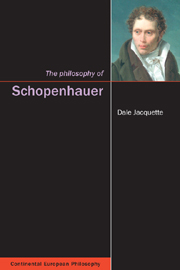Book contents
- Frontmatter
- Contents
- Dedication
- Preface
- Acknowledgements
- A note on texts and terminology
- Abbreviations
- Introduction: Schopenhauer's life and times
- 1 Schopenhauer's idealism
- 2 Empirical knowledge of the world as representation: from natural science to transcendental metaphysics
- 3 Willing and the world as Will
- 4 Suffering, salvation, death, and renunciation of the will to life
- 5 Art and aesthetics of the beautiful and sublime
- 6 Transcendental freedom of Will
- 7 Compassion as the philosophical foundation of morality
- 8 Schopenhauer's legacy in the philosophy of Nietzsche, Heidegger and the early Wittgenstein
- Notes
- Bibliography and recommended reading
- Index
3 - Willing and the world as Will
- Frontmatter
- Contents
- Dedication
- Preface
- Acknowledgements
- A note on texts and terminology
- Abbreviations
- Introduction: Schopenhauer's life and times
- 1 Schopenhauer's idealism
- 2 Empirical knowledge of the world as representation: from natural science to transcendental metaphysics
- 3 Willing and the world as Will
- 4 Suffering, salvation, death, and renunciation of the will to life
- 5 Art and aesthetics of the beautiful and sublime
- 6 Transcendental freedom of Will
- 7 Compassion as the philosophical foundation of morality
- 8 Schopenhauer's legacy in the philosophy of Nietzsche, Heidegger and the early Wittgenstein
- Notes
- Bibliography and recommended reading
- Index
Summary
Here we already see that we can never get at the inner nature of things from without. However much we may investigate, we obtain nothing but images and names. We are like a man who goes around a castle, looking in vain for an entrance, and sometimes sketching the facades. Yet this is the path that all philosophers before me have followed.
(WWR 1: 99)Thing-in-itself
We now stand ready with Schopenhauer to cross over from the world as representation to thing-in-itself. Schopenhauer observes that no previous philosophers had been able to make progress with respect to understanding thing-in-itself, but have had to satisfy themselves with only negative characterizations of it as unknowable. They have thought of it only as something other than the world of phenomena, as noumena, in Kant's critical idealist terminology, or that which lies beyond the veil of Maya.
What shall we find on the other side? In one sense, we should have learned from Schopenhauer's discussion of explanation in the world as representation that such a question as it would usually be understood is misplaced. We are not literally travelling across a borderline where we can exercise our ordinary methods of gathering information and verifying knowledge in the transcendental world just as in the empirical. Schopenhauer states that we cannot hope to acquire representational knowledge of thing-in-itself. The most we can expect in transcendental metaphysics is insight, intuitive grasp or inchoate understanding of thing-in-itself.
- Type
- Chapter
- Information
- The Philosophy of Schopenhauer , pp. 71 - 107Publisher: Acumen PublishingPrint publication year: 2005



